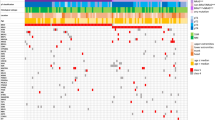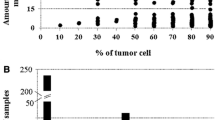Abstract
Introduction
The role of genes involved in the control of progression from the G1 to the S phase of the cell cycle in melanoma tumors is not fully known.
Material and methods
The aims of our study were to analyse alterations in p53, p21, p16 and p15 genes in melanoma tumors and melanoma cell lines by single strand conformational polymorphism (SSCP), and to detect homozygous deletions. We analysed the DNA from 39 patients with primary and metastatic melanomas, and from 9 melanoma cell lines.
Results
The SSCP technique showed heterozygous defects in the p53 gene in 8 or 39 (20.5%) melanoma tumors: three point mutations in intron sequences (introns 1 and 2) and exon 10, and three new polymorphisms located in introns 1 and 2 (C to T transition at position 11701 in intron 1; C insertion at position 11818 in intron 2; and C insertion at position 11875 in intron 2). One melanoma tumor exhibited two heterozygous alterations in the p16 exon 1 (stop codon and missense mutation). No defects were found in the remaining genes. Homozygous deletions were more frequent in melanoma cell lines than in melanoma tumors in p21, p16 and p15 (22.2%, 44.4%, and 44.4% versus 7.7%, 2.5%, and 5.1% respectively). TP53 did not show homozygous deletions.
Conclusions
Our results suggest that these genes are involved in melanoma tumorigenesis; but perhaps not in the major targets. Other suppressor genes that may be informative of the mechanism of tumorigenesis in skin melanomas need to be studied.
Similar content being viewed by others
References
Ekholm SV, Reed SI. Regulation of G1 cyclin-dependent kinases in the mammalian cell cycle. Curr Opin Cell Biol. 2000;12:676–84.
Sherr CJ, Roberts JM. CDK inhibitors: positive and negative regulators of G1-phase progression. Genes Dev. 1999;13:1501–12.
El-Deiry W, Tokino T, Velculescu VE, et al. WAFI, a potential mediator of p53 tumor suppression. Cell. 1993; 75:817–25.
Harper JW, Adami G, Wei N, Keyomarsi K, Elledge S. The p21 cdk-interacting protein Cipl is a potent inhibitor of G1 cyclin-dependent kinases. Cell. 1993;75:805–16.
Toyoshima H, Hunter T. p27, a novel inhibitor of G1 cyclin/cdk protein kinase activity, is related to p21. Cell. 1994;78:67–74.
Lee MH, Reynisdottir I, Massagué J. Cloning of p57KIP2, a cyclin-dependent kinase inhibitor with unique domain structure and tissue distribution. Genes Dev. 1995; 9:639–49.
Ruas M, Peters G. The p16INKa/CDKN2A tumor suppressor and its relatives. Biochim Biophys Acta Rev Cancer. 1998;1378:F115–77.
Serrano M, Hannon GJ, Beach D. A new regulatory motif in cell cycle control causing specific inhibition of cyclin D/CDK4. Nature. 1993;366:704–7.
Hannon GJ, Beach D. p15INK4b is a potential effector of TGFβ-induced cell cycle arrest. Nature. 1994;371:257–61.
Hirai H, roussel MF, Kato J, Ashmun RA, Sherr CJ. Novel INK4 proteins, p19 and p18, are specific inhibitors of the cyclin D-dependent kinases CDK4 and CDK6. Mol Cell Biol. 1995;15:2672–81.
Lohrum M, Vousden K. Regulation and function of the p53-related proteins: same family, different rules. Trends Cell Biol. 2000;10:197–202.
Rich T, Allen RL, Wyllie AH. Defying death after DNA damage. Nature. 2000;407:777–83.
Hainaut P, Soussi T, Shomer B, et al. Database of p53 gene somatic mutations in human tumors and cell lines: updated compilation and future prospects. Nucleic Acids Res. 1997;25:151–7.
Zhang SY, Klein-Szanto AJ, Sauter ER, et al. Higher frequency of alterations in the p16/CDKN2 gene in squamous cell carcinoma cell lines than in primary tumors of the head and neck. Cancer Res. 1994;54:5050–3.
Nobori T, Miura K, Wu DJ, Lois A, Takabayashi K, Carson DA. Deletions of the cyclin dependent kinase 4 inhibitor gene in multiple human cancers. Nature. 1994; 368:753–6.
Yonghas T, Quian H, Chuanyuan L, Yandell DW. Deletions and point mutations of p16, p15 genes in primary tumors and tumors cell lines. Chin Med Sci J. 1999; 14:200–5.
Kawamura M, Ohnishi H, Guo SX, et al. Alterations of the p53, p21, p16, p15 and RAS genes in childhood T-cell acute lymphoblastic leukemia. Leuk Res. 1999; 23:115–26.
Moles JP, Moyret C, Guillot B, et al. p53 gene mutations in human epithelial skin cancers. Oncogene. 1993;8: 583–8.
Campbell C, Quinn AG, Ro YS, Angus B, Rees JL. p53 mutations are common and early events that precede tumor invasion in squamous cell neoplasia of the skin. J Invest Dermatol. 1993;100:746–8.
Lubbe J, Reichel M, Burg G, Kleihues P. Absence of p53 gene mutations in cutaneous melanoma. J Invest Dermatol. 1994;102:819–21.
Hartmann A, Blaszyk H, Cunningham JS, et al. Overexpression and mutations of p53 in metastatic malignant melanomas. Int J Cancer. 1996;67:313–7.
Zerp SF, Elsas A van, Peltenburg LTC, Schrier PI. P53 mutations in human cutaneous melanoma correlate with sun exposure but are not always involved in melanogenesis. Br J Cancer. 1999;79:921–6.
Giglia-Mari G, Sarasin A. TP53 mutations in human skin cancers. Hum Mutat. 2003;21:217–28.
Chin L. The genetics of malignant melanoma: lessons from mouse and man. Nat Rev Cancer. 2003;3:559–70.
Hayward NK. Genetics of melanoma predisposition. Oncogene. 2003;22(20):3053–62.
Matsumura Y, Nishigori C, Yagi T, Imamura S, Takebe H. Mutations of p16 and p15 tumor suppressor genes and replication errors contribute independently to the pathogenesis of sporadic malignant melanoma. Arch Dermatol Res. 1998;290:175–80.
Kirkin AF, Petersen TR, Olsen AC, Li L, thor Straten P, Zeuthen J. Generation of human-melanoma-specific T lymphocyte clones defining novel cytolytic targets with panels of newly established melanoma cell lines. Cancer Immunol Immunother. 1995;41:71–6.
Orita M, Suzuki Y, Sekiya T, Hayashi K. Rapid and sensitive detection of point mutations and DNA polymorphisms using polymerase chain reaction. Genomics. 1989;5:874–9.
Prosser J. Detecting single-base mutations. TIBTECH. 1993;11:238.
Oliva MR, Saez GT, Latres E, Cordon-Cardo C. A new polymorphic site in intron 2 to TP53 characterizes LOH in human tumors by PCR-SSCP. Diagn Mol Pathol. 1995;4:54–8.
Cleaver JE, Crowley E. UV damage, DNA repair and skin carcinogenesis. Front Biosci. 2002;7:1024–43.
Ziegler A, Leffell DJ, Kunala S, et al. Mutation hotspots due to sunlight in the p53 gene of non-melanoma skin cancers. Proc Natl Acad Sci USA. 1993;90:4216–20.
Soussi T. The p53 tumour suppressor gene: a model for molecular epidemiology of human cancer. Mol Med Tod. 1996;2:32–7.
Mendoza-Rodríguez CA, Cerbon MA. Tumor suppressor gene p53: mechanisms of action in cell proliferation and death. Rev Invest Clin. 2001;53:266–73.
Hahn M, Serth J, Fislage R, et al. Polymerase chain reaction detection of a highly polymorphic VNTR segment in intron 1 of the human p53 gene. Clin Chem. 1993;39:549–50.
Ito T, Seyama T, Hayashi T, et al. Hae III polymorphism in intron 1 of the human p53 gene. Human Genet. 1994;93:222.
Lazar V, Hazard F, Bertin F, Janin N, Bellet D, Bressac B. Simple sequence repeat polymorphism within the p53 gene. Oncogene. 1993;8:1703–5.
Peller S, Kopilova Y, Slutzki S, Halevy A, Kvitko K, Rother V. A novel polymorphism in intron 6 of the human p53 gene: a possible association with cancer predisposition and susceptibility. DNA Cell Biol. 1995;14:983–90.
Mavridou D, Gornall R, Campbell IG, Eccles DM. TP53 intron 6 polymorphism and the risk of ovarian and breast cancer. Br J Cancer. 1998;77:676–7.
Hillebrandt S, Streffer C, Demidchik EP, Biko J, Reiners C. Polymorphisms in the p53 gene in thyroid tumours and blood samples of children from areas in Belarus. Mutat Res. 1997;381:201–7.
Prosser J, Condie A. Biallelic ApaI polymorphism of the human p53 gene (TP53). Nucleic Acids Res. 1991;19:4799.
Buller RE, Skilling JS, Kaliszewski S, Niemann T, Anderson B. Absence of significant germline p53 mutations in ovarian cancer patients. Gynecol Oncol. 1995; 58:368–74.
Runnebaum IB, Tong XW, Konig R, et al. p53-based blood test for p53PIN3 and risk for sporadic ovarian cancer. Lancet. 1995;345:994.
Sjalander A, Birgander R, Athlin L, et al. p53 germline haplotypes associated with increased risk for colorectal cancer. Carcinogenesis. 1995;16:1461–4.
Birgander R, Sjalander A, Rannug A, et al. p53 polymorphisms and haplotypes in lung cancer. Carcinogenesis. 1995;16:2233–6.
Birgander R, Sjalander A, Zhou Z, Fan C, Beckman L, Beckman G. p53 polymorphisms and haplotypes in nasopharyngeal cancer. Hum Hered. 1996;46:49–54.
Ge H, Lam WK, Lee J, et al. Detection and evaluation of p53 intron 2 polymorphism in lung carcinomas in Hong Kong. Int J Cancer. 1996;69:120–4.
Ruiz A, Puig S, Lynch M, Castel T, Estivell X. Retention of the CDKN2A locus and low frequency of point mutations in primary and metastatic cutaneous malignant melanoma. Int J Cancer. 1998;76:312–6.
Sauroja I, Smeds J, Vlaykova T, et al. Analysis of G(1)/S checkpoint regulators in metastatic melanoma. Genes Chromosomes Cancer. 2000;28:401–14.
Foulkes WD, Flanders TY, Pollock PM, Hayward NK. The CDKN2A (p16) gene and human cancer. Mol Med. 1997;3:5–20.
Pollock PM, Welch J, Hayward NK. Evidence for three suppressor loci on chromosome 9p involved in melanoma development. Cancer Res. 2001;61:1154–61.
Huschtscha LI, Reddel RR. p16(INK4a) and the control of cellular proliferative life span. Carcinogenesis. 1999;20:921–6.
Soufir N, Basset-Seguin N. The INK4a-ARF locus: role in the genetic predisposition to familial melanoma and skin carcinogenesis. Bull Cancer. 2001;88:1061–7.
Wagner SN, Wagner C, Briedigkeit L, Goos M. Homozygous deletion of the p16INK4a and the p15INK4b tumour suppressor genes in a subset of human sporadic cutaneous malignant melanoma. Br J Dermatol. 1998; 138:13–21.
Gartel AL, Tyner AL. Transcriptional regulation of the p21 (WAF/CIP1) gene. Exp Cell Res. 1999;246:280–9.
Author information
Authors and Affiliations
Corresponding author
Rights and permissions
About this article
Cite this article
Martínez, J.L.S., Morales, C.M.C., Ortega, S.S. et al. Mutation and homozygous deletion analyses of genes that control the G1/S transition of the cell cycle in skin melanoma: p53, p21, p16 and p15. Clin Transl Oncol 7, 156–164 (2005). https://doi.org/10.1007/BF02708753
Received:
Revised:
Accepted:
Issue Date:
DOI: https://doi.org/10.1007/BF02708753




